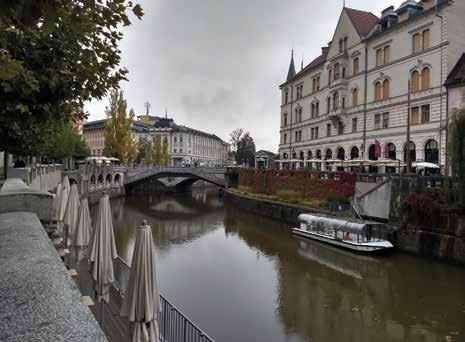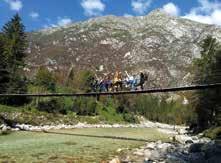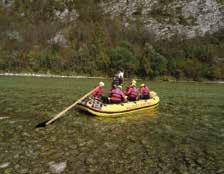
12 minute read
Travel - Slovenia
TRAVEL
Slovenia By Kathryn Gerken
As an independent travel agent and avid traveller, I have visited many places in Europe. One of the highlights was a three-day visit to Slovenia last October with the American Women’s Club of London. Wow! I could have stayed there for a whole week or more. Slovenia’s natural beauty and friendly people make it one of my top recommendations for places to visit. Coupled with a trip into Croatia, just an hour away by car to the border from the capital of Ljubljana, it would make a great two-week getaway.
Ljubljana: Explore The Markets And Medieval Old Town With fewer tourists and cooler temperatures, Slovenia was an excellent choice for the fall. We started our trip in Ljubljana, only a 90-minute flight from London or other connecting European cities. Our tour guides picked us up and transferred us to our hotel, where we relaxed before going out to tour the picturesque Old Town.
Straddling the Ljubljanica River, the Old Town is a joy to walk around. Head to the local craft and farmers markets and sample some of the honey liquor or any of the honey products, which are outstanding. They also have a Christmas market in December with activities and concerts during the season. The hilltop Ljubljana Castle, with interactive exhibits for families, provides panoramic views of the medieval streets below.
Slovenia became independent in 1997, so it is a new country with an old heritage, language, and tradition. They are immensely

Slovenia became independent in 1997, so it is a new country with an old heritage, language, and tradition. They are immensely proud of their country and love to talk about it and show it off to travellers
proud of their country and love to talk about it and show it off to travellers. Spending more than the few hours we had would be beneficial. There are concert halls, museums and several other attractions for families.

Triglav National Park: An Easy Trek To The Gorge Ljubljana would make a great home base if you want to only unpack once during your stay. From here you can take day trips to almost anywhere in Slovenia. We chose to travel around and spend the night in different parts of the country, so our next stop was the Vintgar Gorge inside the Triglav National Park.
The trail was mainly a boardwalk with some areas of dirt. Thankfully, there is a railing on sections that have a significant drop into the gorge, and at no time was I concerned for our safety. We were there on a Monday and there were quite a few walkers on the trail. We heard it was significantly more crowded over the weekend. At the end of the boardwalk/trail there is a little café with refreshments and a restroom. It had rained earlier in the week and the falls were outstanding. Trout are visible in the crystal clear river and a restaurant up the road near the parking entrance serves it (whole with garlic) for lunch. It was delightful! Cash is recommended for food and beverage in more remote places like this.
Lake Bled: Row To An Idyllic Island Next, we went to Lake Bled and took a traditional rowboat ride out to its iconic island. Rowed by the boatman, the ornately decorated vessels are a sight to behold and a great experience, even if you do not want to visit the island. Upon landing, we walked the paved path around the very small island, read about the history, hit the gift shop, and visited the main attraction - a church with a bell tower and sweeping views. Here you can ring the lucky church bell and make a wish. You can also stay the night at Lake Bled if accommodations are available. Advanced bookings during high season are a must. Make sure to stop at a lakeside café and try the traditional cream cake. Consider sharing, or not - it is extraordinarily rich!
Active Travel: From Alpine Peaks To River Rafting The Slovenia Alps, which border Austria and Italy, are gorgeous. We were lucky enough to have a sunny day and could see all the peaks at the top of the pass we went through. You will find many hiking trails here in the summer and skiing in the winter. Like many areas, you should plan to bring your own food and water. It is very remote, and does not have many facilities or shops.
For a little adventure, we took a guided rafting trip down the Soča River. This was considered a level 3 river at this time of year and Neoprene gear and helmets were provided. We carried the raft to the water and out again. The guide gave plenty of instruction in the calm water to prepare

us for the swifter water with rapids. In the middle of the route was a smaller waterfall with a natural waterslide that we were free to enjoy. By the end of the 2-hour trip we were slightly wet but felt very accomplished and invigorated. Plus, we did not tip over! Bonus points! Note: This group activity could be used as a team-building exercise as well.
Wine Country: Visiting “Mini Tuscany” To top off our trip we went to the southwest of Slovenia into the wine country of Brda. Spanning the rolling hills between the Soča River and the eastern Italian border, Brda is one of Slovenia’s foremost winegrowing areas and only an hour’s drive from Ljubljana, which made it the perfect last stop on our tour. Often described as a miniature version of Tuscany, every hill seems to be topped with a large church surrounded by a charming little village, while the hillsides and valleys in between are blanketed with vineyards, orchards, and winding country roads. We walked the vineyards and sampled both white and red wines along with local meats and cheese. Slovenia is not a new wine growing region; they have been growing vines for hundreds of years. The vineyard that we visited is at least three generations old. We stayed in a tiny village of Brda with good accommodations and meals. This would be a great area to stay longer and do some more hiking or cycling.
We could have stayed longer. We were not able to see the outstanding caves or the coastline of the country, and I left Slovenia wanting more. Someday, I will return and continue the exploration, and possibly get into Croatia too.
Travelling With The American Women’s Club The American Women’s Club (AWC) of London organises travel opportunities for its members several times a year.

Over the past year, they have visited Krakow, San Sebastian, and Marrakesh. The club also offers a range of social, cultural, and educational activities, both in-person and virtual. Learn more at www.awclondon.org.
Kathryn Gerken Kathryn moved from Seattle to London for her husband’s work. She runs her US-based travel agency, Gerken Getaways, remotely during this time.
ARTS & ANTIQUES Meet The Artist: Carol Ann Eades By Dr Susan House Wade
Carol Ann Eades in her island studio


Fragments of Life shortlisted for Royal Academy Summer Show 2017
On first glance, it would appear that this glorious, light-filled studio, packed with intriguing indigo-dyed textile creations, may well be situated high in a remote Japanese village. But it’s not. Everything on display here was conceived and produced just a few blocks from the sea in the south of England.
Although Carol Ann Eades is not native to these parts (she grew up in a cotton mill town in Lancashire), she obviously thrives here. Her textiles studio on the Isle of Wight is where she spends much of her time, when she’s not travelling to Japan or Southeast Asia. This is where she conducts most of her dyeing activities, utilising all natural materials, and combining indigo, rust and plant materialbased botanical print techniques to produce the most phenomenal outcomes.
Interestingly, she reflects on how textiles were considered an industrial pursuit, and not an art form in her school days, and so Carol Ann’s career path was channeled first into the architectural field, but later she trained as an art, design and technology teacher. Had she grown up in Japan, however, she would have found no clear delineation between artists and craftspeople, with any and all forms of artistic production being equally well regarded.

Following an early career in teaching art and design to adults and children with learning disabilities, the opportunity presented itself for her to establish a textile department at an art centre in Cambridgeshire. It was at this stage that she really began to take on the significance of textiles as an art form, and her own inspired practice emerged in a highly vigorous way.
Carol Ann has recently been profoundly impacted by the Asian textiles which she has come across during her travels. In fact, it was as a result of these discoveries that she originally began working with indigo dyes on natural fabrics.
The interest continued, and she went on to study at West Dean College in Sussex with Canadian indigo and shibori-dyeing authority, Bryan Whitehead, who lives, farms and practices in the mountain village of Fujino, Japan (near Tokyo).
Shibori is an ancient dyeing method which utilises a resist-dyeing technique, and which has, over many centuries, become well established and widely recognised as a significant element within the legacy of the Japanese arts. This ancient methodology is characterised by patterns which are created on cloth during the dyeing process via twisting, binding, stitching or folding, and in this way, it differs dramatically from what is known in European countries and North America as tie-dyeing.
She cites other compelling influences, including Textile Artist Reiko Sudo of NUNO, and the noren, the cloth which is traditionally found hanging across the entrance to a shop or restaurant in Japan, the most common colour of which is indigo. Carol Ann’s ramblings in Tokyo have also taken her to the Mingeikan in Shibuya, the folk art museum which houses the vast collection of popular arts gathered by the philosopher, art critic and founder of the Japanese folk art movement, Sōetsu Yanagi. It was here that she found even further inspiration, in the form of the many and varied Japanese handcrafted textiles on show.
Carol Ann incorporates both the shibori and the sashiko techniques in her work. Originally devised for utilitarian purposes in Edo (1603-1868) Japan, sashiko is a form of reinforcement stitching, which, in modern times, serves the added function of lending a contemporary, decorative aspect to the piece of work. Its original usage, however, was for repairing and mending torn or worn out garments, which were required for work such as farming, sake production or in the building trades.
Nestled inside a greenhouse in the Ventnor Botanical Gardens, in the far southeast corner of the Isle of Wight, Carol Ann keeps a thriving, working studio, dependent on season. As Artist in Residence there, and with botanical specimens galore, the gardens provide an ever changing inspiration for her work. It is here that she developed her own
Zukin 2020 shown at Japanese Craft and Textile Festival, London

interpretation of the eco print technique, which draws heavily upon the 37 eucalyptus varieties found in the gardens.
Presently, Carol Ann is spending the bulk of her time on the Japanese Firefighters Hood (Kaji Zukin) Project, which she characterises as effectively merging influences derived from Japanese methodology (including sashiko and shibori) alongside her own ongoing design practice.
The tradition of these hoods began in the Edo period, when firefighters required fireproofed and reinforced coats and hoods, and hence this construction style came

Boro 2016 Sashiko technique

Shibori dyed textiles at Summer Open Studios 2019

into wide usage. Shown here is her image called Zukin, featuring the hoods, which was exhibited at Craft Central, Isle of Dogs, London, as a part of the Japanese Craft and Textile Festival in March 2020. This work is both indigo-dyed and sashiko stitched. She was shortlisted for the Royal Academy Summer Show in 2017, with the mixed media work seen here, entitled Fragments of Life. The real standout for me, however, is Carol Ann’s Kyoto Garden, which was inspired by her trips to various wintry Kyoto garden landscapes. It is in Kyoto, as the old capital of Japan (794-1868), that literally dozens of not only historically important, but also incredibly sensitive and aesthetically beautiful gardens can be found and visited all year long. This extraordinary work features just such a garden, using hand stitching, alongside her ever-present rich indigo dye.
At this very moment, pollen molecules and their potential usage is the subject of an informal research project for Carol Ann, and she is working, along with Sculptor Ken Proust and the Wellcome Collection on the development of it. I am watching with intense curiosity to see how this innovative project unfolds.
Carol Ann’s island studio is open by appointment to see work in progress, attend workshops and to make purchases.










